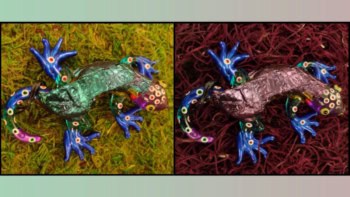Physicists are involved in an unusually heated debate over the reality of a new kind of refraction and about the possibility of making perfect lenses. Edwin Cartlidge reports.

If you think science is a smooth progression towards objective truth then a dispute in the normally cordial world of optics research might make you think again. The disagreement concerns one of the most fundamental and best-known phenomena in optics – refraction. One set of researchers believes that a certain class of materials can refract light rays “negatively” and that these materials could be used to make “perfect lenses”. But others think that negative refraction defies fundamental physical laws. Although it is unclear which view is correct, one thing is certain: neither side is going to give in without a fight.
Negative refraction was first predicted by Soviet physicist Victor Veselago in the 1960s. He calculated that a material that had a negative permittivity and a negative permeability would also have a negative refractive index. He showed that light rays entering such a material – known as a “negative-index medium” – would not be bent towards the normal, as happens in conventional materials, but past the normal.
However, Veselago’s prediction remained untested for many years because materials with a negative permeability do not occur naturally, although those with a negative permittivity do. Then, in 1999, John Pendry of Imperial College in London and co-researchers from Marconi suggested how materials with negative permeability could be created artificially. Furthermore Pendry published a paper the following year in which he calculated that a negative-index medium could be used to make a perfect lens that would focus an image with a resolution not restricted by the wavelength of light (Electromagnetic materials enter the negative age, see summary) or Physics World September 2001 pp47-51, print version).
In 2000 David Smith of the University of California at San Diego and colleagues constructed the first negative-index medium. Their material did not resemble the typical glass block used to demonstrate refraction in physics classrooms – it was actually a grid of thin copper wires and split copper rings mounted on a circuit board (see figure). By subsequently sending microwaves through a sample of this material and measuring the angle at which they were transmitted, Smith’s group claimed that it had observed negative refraction.
If correct this claim would not only rewrite the laws of optics but might also lead to applications including ultra-high-capacity DVDs and smaller, faster computer chips. However, research published earlier this year in the journal Physical Review Letters has put the whole matter in doubt. Prashant Valanju and colleagues at the University of Texas in Austin worked out that negative refraction would violate the fundamental limit of the speed of light (Phys. Rev. Lett. 2002 88 187401). In addition Nicolas Garcia and Manuel Nieto-Vesperinas of the Consejo Superior de Investigaciones Cientificas in Madrid calculated that a perfect lens would require an infinite amount of energy to operate (Phys. Rev. Lett. 2002 88 207403).
Beyond the normal
In their paper Valanju and colleagues imagine a parallel beam of light travelling from a material with a positive index of refraction to one with a negative index. They point out that if the beam is travelling at an angle to the interface between the two materials then different points on the beam’s wavefront – which is at right angles to beam direction – will arrive at the interface at different times. But, they say, if the beam is to be refracted past the normal then when any one point arrives at the interface any other point still in the positive-index material will have to travel with infinite velocity to keep the wavefront perpendicular to the beam.
The Texas researchers point out that this argument would not apply to a light beam consisting of just one frequency. But they maintain that in a negative medium it is not possible to approximate a real beam – which will have a finite spread of frequencies and a “group” velocity – with the idealized case of a single frequency that can be described by a “phase” velocity.
“Physicists often use monochromatic waves in their calculations because they approximate to real waves in positive media,” says Valanju. “But this is simply not the case for refraction between positive- and negative-index media.”
In a comment submitted to Physical Review Letters in response to the paper from Valanju and colleagues, Pendry counters that when a beam passes between positive- and negative-index media the group velocity is negatively refracted. He says that the Texas group wrongly identifies group velocity with the interference front between separate frequency components. Valanju says he is reluctant to discuss the issue while the comment is still under review, but he states that identifying group velocity with the motion of the interference pattern is not only correct, but is, in fact, the very definition of group velocity.
Valanju’s group maintains that the flaws in Pendry’s calculations invalidate the outcome of Smith’s experiment; though they say the experimental results themselves are fine. In addition Garcia, Nieto-Vesperinas and colleagues in Madrid say they have observed results similar to that of Smith’s group but in a sample of material known to have a positive refractive index. They argue that the apparent negative refraction is caused by the way in which the sample – which is wedged shaped – absorbs the incoming waves.
Smith, however, believes the Spanish group has miscalculated the energy losses in the thin copper wires used in the experiment, and points out that Claudio Parazzoli at Boeing has since carried out a more sensitive version of the same experiment and observed very similar results.
Focusing debate
It is not just negative refraction itself that is in dispute, however. Garcia and Nieto-Vesperinas also believe that Pendry’s perfect-lens paper is wrong. In any object atomic dipoles emitting visible light generate electric fields that surround the object with “evanescent” waves. These waves would reveal features that are smaller than the wavelength of light but they cannot propagate away from the object because they lack a magnetic component; consequently they decay very sharply. Pendry, however, has calculated that evanescent waves can be amplified by a slab of negative-index material. He says that if they are amplified by just the right amount, these waves can be brought to a focus at the same position as an object’s radiative field, thereby producing an image that has sub-wavelength detail.
However, Garcia and Nieto-Vesperinas argue that even in an idealized negative-index medium evanescent waves would only undergo partial amplification. But, in any case, they say that in a real material absorption would destroy amplification. Pendry maintains that absorption would only partially impair the lensing effect. In reply Garcia and Nieto-Vesperinas say that Pendry has not properly considered absorption, and that if it is factored in properly it makes perfect lensing impossible.
Divergent views
Not only do both sides of the argument think that the other side is wrong but they also say that everyone else they have spoken to agrees with them. Pendry says that he has recently attended two conferences on negative refraction and that he did not hear any dissenting voices. “There was hardly a murmur when I presented my results,” he says. “It has become obvious which way the wind is blowing.” He estimates that there are now about 100 groups around the world working on negative refraction, many of which, he says, are producing calculations, computer simulations and experimental results that support his point of view. “Valanju and his colleagues made a rather elementary mistake,” he adds. “In our minds the issue is resolved.”
Duncan Haldane, a condensed-matter theorist at Princeton University, has taken an interest in the subject and has come out on the side of Pendry. “There is no basic problem with negative refraction and I see no objection to the principles underlying a ‘perfect lens’,” he says. “As first presented Pendry’s proposal has a ‘too good to be true’ feel about it – like a perpetual motion machine – which I think is what has upset the critics.”
On the other hand, Marlan Scully, a laser physicist and quantum optician at Texas A&M University, and, like Haldane, an outsider to the debate, supports Valanju and colleagues. “They are very good people and I agree with their perspective,” he says.
Rodger Walser, one of Valanju’s colleagues, is keen that the debate is resolved through rigorous peer review and says he does not view the discussion as a dispute. But to an outsider that is how it appears, with neither side prepared to concede any ground. With everyone convinced that they are right, it seems that this episode has a way to run yet.




